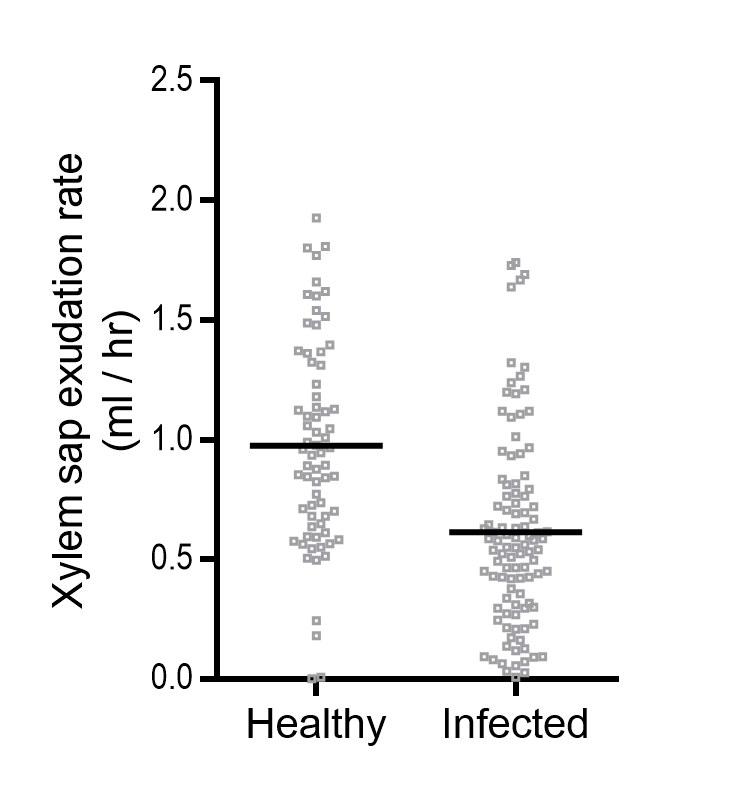protocols
Lab protocols for the Lowe-Power lab (scroll down for table of contents Readme)
Harvesting Tomato Xylem Sap by Root Pressure
Writing/Editing Credits: Tiffany Lowe-Power, Patrizia Ricca
This protocol assumes you have tomato plants (>3 weeks old) that have been grown in potting soil
Important physiology knowledge for sap harvesting
- Root pressure builds up overnight if plants are well-watered, but not water-logged.
Water-logged soil will make roots hypoxic.
Root pressue will descrease throughout the light period.
- Practical advice: Plan to harvest xylem sap in the morning (within 4 h of light onset). Before leaving work the day before harvesting, water plants well (i.e. so that soil is thoroughly soaked, but that run-off does not significanly pool in the tray)
- Physical pressure on the stem can influence metabolite composition of sap.
- Practical advice: Avoid squeezing the stem. Use a sharp blade (less pressure than a dull blade). When making the first cut, stabilize the plant by holding ‘top parts’ of plant with non-dominant hand.
- Sap follows the rules of capillary action.
- Practical Advice: Make a flat, non-jagged stump for sap to pool. If stump appears damp, but a sap-bubble does not form, the sap is discretely flowing down the stem. Gently rinsing the stump & gently blotting dry the stump surface and side of the stem will discourage. Making sure sides of stem are dry first will deter capillary action sucking the sap down the sides.
- Freeze / thaw can lyse bacteria.
- Practical Advice: Remove bacteria from sap before freezing. Centrifugining at a minimum; centrifuging + filtering with 0.22 um for sensitive experiments. Harvest sap into tubes on wet ice, not on -20 freezer blocks or on dry ice.
- Sap flow rate is variable between plants and that has consequences.
Slower flowing sap is generally more concentrated with solutes than fast-flowing sap.
- Practical Advice: When pooling, pool equal volumes between individual plants (unless it does not affect your experiment/hypothesis if the fast-flowing plants’ sap dilutes signal in the slower plants).
- Width of stem is positively correlated with sap flow volume (wider stems = more vessels)
- Ralstonia infection decreases sap flow vol.
- Distribution of accumulated sap vol in ~4 week old Bonny Best tomato; healthy vs. wilt symptomatic for < 16 h (data source):

- Sap composition reportedly does not change noticeably over time.
- Practical Advice: Although previous iterations of xylem sap sampling protocols/methods limited the sampling window to 3 hr, this appeared to be overly cautious.
Protocol
- Arrange collection tubes on wet ice.
- For precise assays, 1x 1.5 ml microtube per plant – preferably spatially arranged to match plant arrangement. less mistakes
- For course assays, collect sap from all plants from a condition into 15 ml or 50 ml conical.
- Detop each plant with a smooth, horizontal cut using a sharp razor blade.
- Cut site: Cut at the
cotyledon juncturefor healthy / soil drench inoculated plants. Cut at thepetiole woundfor petiole-inoculated / mock inoculatd plants. - If you accidentally cut at an angle, make a fresh horizontal cut.
- Switch to a new razor blade after 5 plants, but sterilize it for reuse for less sensitive protocols. Generally, it works well to stagger plants in batches of 5.
- You may want to keep (and label) the aerial portion of the plant for subsequent dilution plating.
- Cut site: Cut at the
-
Allow initial sap to pool on the stump for ~3 min. Blot away first-sap with kimwipe and rinse sap with dI H2O with a P200 pipette. Blot dry again. This washes plant-cell cytosolic contamination from the stump
- Collect sap for a uniform amount of time (e.g 30 min up to 2 h).
- Just in case there turn out to be differences in sap composition… don’t let that variation confound your data. Record the sampling time in your experimental notes

Misc. notes
-
If you want to measure sap volume per plant, pre-weigh collection tubes and weigh tube after collection. Sap has similar density to water, so
1 mg = 1 ml. -
If filter sterilizing sap, consider the 4 mm diameter filters with 0.22 um pores (e.g. Corning #431212). Less volume will be lost, but also easier to clog! Pellet cells/debris first!